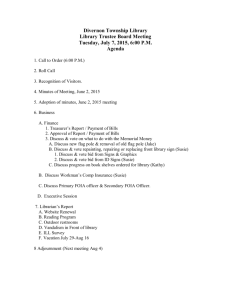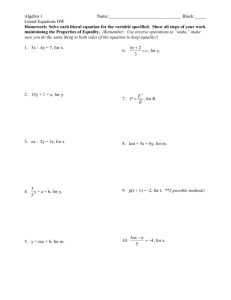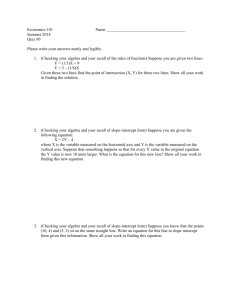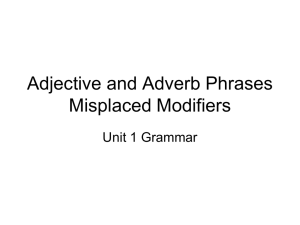Before Rosa Parks: Susie King Taylor
advertisement
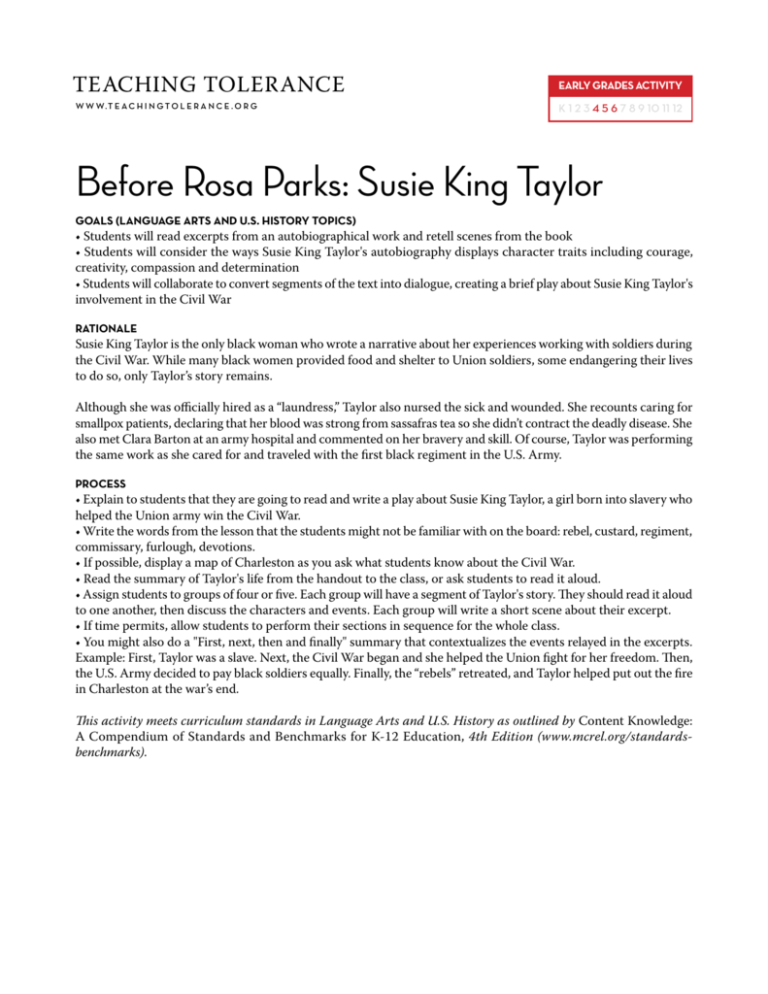
Teaching Tolerance w w w.t e a c h i n g t o l e r a n c e . o r g early grades activity K 1 2 3 4 5 6 7 8 9 10 11 12 Before Rosa Parks: Susie King Taylor Goals (Language Arts and U.S. History topics) • Students will read excerpts from an autobiographical work and retell scenes from the book • Students will consider the ways Susie King Taylor's autobiography displays character traits including courage, creativity, compassion and determination • Students will collaborate to convert segments of the text into dialogue, creating a brief play about Susie King Taylor's involvement in the Civil War Rationale Susie King Taylor is the only black woman who wrote a narrative about her experiences working with soldiers during the Civil War. While many black women provided food and shelter to Union soldiers, some endangering their lives to do so, only Taylor’s story remains. Although she was officially hired as a “laundress,” Taylor also nursed the sick and wounded. She recounts caring for smallpox patients, declaring that her blood was strong from sassafras tea so she didn’t contract the deadly disease. She also met Clara Barton at an army hospital and commented on her bravery and skill. Of course, Taylor was performing the same work as she cared for and traveled with the first black regiment in the U.S. Army. Process • Explain to students that they are going to read and write a play about Susie King Taylor, a girl born into slavery who helped the Union army win the Civil War. • Write the words from the lesson that the students might not be familiar with on the board: rebel, custard, regiment, commissary, furlough, devotions. • If possible, display a map of Charleston as you ask what students know about the Civil War. • Read the summary of Taylor's life from the handout to the class, or ask students to read it aloud. • Assign students to groups of four or five. Each group will have a segment of Taylor's story. They should read it aloud to one another, then discuss the characters and events. Each group will write a short scene about their excerpt. • If time permits, allow students to perform their sections in sequence for the whole class. • You might also do a "First, next, then and finally" summary that contextualizes the events relayed in the excerpts. Example: First, Taylor was a slave. Next, the Civil War began and she helped the Union fight for her freedom. Then, the U.S. Army decided to pay black soldiers equally. Finally, the “rebels” retreated, and Taylor helped put out the fire in Charleston at the war’s end. This activity meets curriculum standards in Language Arts and U.S. History as outlined by Content Knowledge: A Compendium of Standards and Benchmarks for K-12 Education, 4th Edition (www.mcrel.org/standardsbenchmarks). Teaching Tolerance early grades handout w w w.t e a c h i n g t o l e r a n c e . o r g Before Rosa Parks: Susie King Taylor Story Handout At the age of 13, Susie King Taylor escaped from slavery. The Civil War broke out and she went to sea on a gunboat. She wanted to help the soldiers who saved her life. She showed a commander at the army camp that she could write. The camps were on the Sea Islands off South Carolina’s coast. An army commander asked her to start a school. Susie taught children who, like her, had escaped slavery with their families. She ran a small school at each army camp. She had 40 students and taught some of the adults at night. Susie traveled with Union soldiers as they moved to new camps. Some of the soldiers formed the first black troops in the U.S. Army. Some of them were hurt in the war. Susie learned how to nurse them back to health. She was a teacher and a nurse, and Susie also worked in the laundry. Susie’s story talks about these black soldiers. They demanded equal pay when the army wanted to pay them less than white soldiers. They pulled cannons for five miles if they didn’t have a horse. Some of them got smallpox. Susie treated the black and white soldiers equally. Black or white, they worked together for freedom and justice. As you read different sections of Susie’s true story, you will see that she was brave and smart. Susie used her intelligence to solve problems. When she was in danger, she took care of herself. When the soldiers ran out of food, she found things for them to eat. Her story tells us about courage, but some parts of it are funny. As you read about her, think of what kind of person she was. Imagine her talking to friends and the soldiers. Use the worksheets to write a class play about Susie King Taylor’s life during the Civil War. Teaching Tolerance early grades handout w w w.t e a c h i n g t o l e r a n c e . o r g Before Rosa Parks: Susie King Taylor Activity Handout for Group 1 An excerpt from Susie Taylor King’s autobiography: I was born under the slave law in Georgia, in 1848, and was brought up by my grandmother in Savannah. There were three of us with her, my younger sister and brother. My brother and I being the two eldest, we were sent to a friend of my grandmother, Mrs. Woodhouse, a widow, to learn to read and write. She was a free woman and lived on Bay Lane, between Habersham and Price streets, about half a mile from my house. We went every day about nine o’clock, with our books wrapped in paper to prevent the police or white persons from seeing them. We went in, one at a time, through the gate, into the yard to the kitchen, which was the schoolroom. She had twenty-five or thirty children whom she taught, assisted by her daughter, Mary Jane. The neighbors would see us going in sometimes, but they supposed we were there learning trades, as it was the custom to give children a trade of some kind. After school we left the same way we entered, one by one, when we would go to a square, about a block from the school, and wait for each other. We would gather laurel leaves and pop them on our hands, on our way home. Questions for Discussion and Preparation 1. Why do you think the school children had to hide what they were doing? How did they conceal the fact that they were learning to read from neighbors and police? 2. What did the neighbors think the children did at Mrs. Woodhouse’s? 3. How do you think the children felt about learning to read secretly? 4. If this were a play, who would the characters be? 5. Imagine that a policeman sees Susie and her siblings gather after school. What could she say to keep the secret about the school? Use the prompts below to write a scene for a play about Susie. Fill in the blanks with dialogue. Teaching Tolerance early grades handout w w w.t e a c h i n g t o l e r a n c e . o r g A Play about Susie Taylor King: Scene 1 Setting: Sidewalk in front of Mrs. Woodhouse’s school on an autumn day. Susie and her sister leave, one at a time, and run around the corner to meet. They are both carrying school books wrapped in paper. A policeman approaches. Policeman: What are you two doing on this street? Susie: (a little scared, noticing the policeman staring at her book)____________________________________________ _______________________________________________________________________________________________ Policeman: What is that you’re carrying? Susie: A package my mistress asked me to collect for her. Policeman: _________________________________________________________________ (Policeman walks away.) Susie’s sister: (whispering to Susie so the policeman can’t hear) That was ___________________________________ Susie: Well, sister, the most important thing is____________________________________ (The two girls hold hands and start skipping toward home.) Teaching Tolerance early grades handout w w w.t e a c h i n g t o l e r a n c e . o r g Before Rosa Parks: Susie King Taylor Activity Handout for Group 2 An excerpt from Susie Taylor King’s autobiography: The first colored troops did not receive any pay for eighteen months, and the men had to depend wholly on what they received from the commissary, established by General Saxton. A great many of these men had large families, and as they had no money to give them, their wives were obliged to support themselves and children by washing for the officers of the gunboats and the soldiers, and making cakes and pies which they sold to the boys in camp. Finally, in 1863, the government decided to give them half pay, but the men would not accept this. They wanted “full pay” or nothing. They preferred rather to give their services to the state, which they did until 1864, when the government granted them full pay, with all the back pay due. I remember hearing Captain Heasley telling his company, one day, “Boys, stand up for your full pay! I am with you, and so are all the officers.” Questions for Discussion and Preparation 1. Why do you think the government only wanted to give the black soldiers half pay? Who do you think got full pay? 2. What did the black soldiers have to sacrifice by demanding full pay or nothing? 3. Why do you think the government decided to pay the soldiers after all? 4. Name the characters who Susie mentions in this story. 5. Imagine that this story was a scene from a play. What would the plot be? What would the characters say to each other? Use the prompts below to write a scene about this story. Teaching Tolerance early grades handout w w w.t e a c h i n g t o l e r a n c e . o r g A Play about Susie Taylor King: Scene 2 Setting: The meeting place at the center of the black soldiers’ camp. One of the soldiers is passing out mail to the troops. Some soldiers stand around, including Susie, who has just left the tent where she teaches school. Captain Heasley: I have some bad news, soldiers. I got a letter from the government that says they will only pay you half of what the white soldiers get. Susie: But, Captain, how will we ______________________________________________________________________ First soldier: I need that money for ___________________________________________________________________ Susie: Half pay is not enough money to ________________________________________________________________ Second soldier: I deserve full pay because _____________________________________________________________ Captain: You’re right, men. You are as brave all the rest of the soldiers. You risk your life just like they do. First soldier: We need to stand up for ourselves! Second soldier: Yes, we should ______________________________________________________________________ Third soldier: I want to fight for my freedom. I will ______________________________________________________ Teaching Tolerance early grades handout w w w.t e a c h i n g t o l e r a n c e . o r g Before Rosa Parks: Susie King Taylor Activity Handout for Group 3 An excerpt from Susie Taylor King’s autobiography: My work now began. I gave my assistance to try to alleviate their sufferings. I asked the doctor at the hospital what I could get for them to eat. They wanted soup, but that I could not get; but I had a few cans of condensed milk and some turtle eggs, so I thought I would try to make some custard. I had doubts as to my success, for cooking with turtle eggs was something new to me, but the adage has it, “Nothing ventured, nothing done,” so I made a venture and the result was a very delicious custard. This I carried to the men, who enjoyed it very much. My services were given at all times for the comfort of these men. I was on hand to assist whenever needed. I was enrolled as company laundress, but I did very little of it, because I was always busy doing other things through camp, and was employed all the time doing something for the officers and comrades. Questions for Discussion and Preparation 1. Why did Susie want to cook with turtle eggs? 2. What other things do you think Susie did for the sick and wounded soldiers? 3. Why do you think the soldiers wanted soup? 4. If this were a play, who would the characters be? 5. Use the prompts below to write a scene about this story. Teaching Tolerance early grades handout w w w.t e a c h i n g t o l e r a n c e . o r g A Play about Susie Taylor King: Scene 3 Setting: An old barn converted to a hospital. Many soldiers are in cots. Many of them have bandages on the head and body. The doctor is stitching up a large cut on one of the men. Susie is bringing the men water. Susie: Here, have a drink. It will help your fever. Soldier: I’m so _____________________________________________________________________________________ Doctor: These men need ____________________________________________________________________________ Susie: But I don’t have any ___________________________ (Susie stops to think.) But maybe ___________________ ________________________________________________________________________________ (She leaves the tent.) (A few hours later. Susie returns to the tent with a tray and begins passing out bowls of a creamy substance. The men eat hungrily. Susie sits down next to a man with two broken arms and begins spooning the contents of the bowl into his mouth.) Soldier with broken arms: Oh my goodness, Susie _____________________________________________________ Another soldier: What’s in this? Susie: ____________________________________________________________________________________________ Teaching Tolerance early grades handout w w w.t e a c h i n g t o l e r a n c e . o r g Before Rosa Parks: Susie King Taylor Activity Handout for Group 4 An excerpt from Susie Taylor King’s autobiography: I must mention a pet pig we had on Cole Island. Colonel Trowbridge brought into camp, one day, a poor, thin little pig, which a German soldier brought back with him on his return from a furlough. His regiment, the 74th Pennsylvania, was just embarking for the North, where it was ordered to join the 10th corps, and he could not take the pig back with him, so he gave it to our colonel. That pig grew to be the pet of the camp, and was the special care of the drummer boys, who taught him many tricks; and so well did they train him that every day at practice and dress parade, his pigship would march out with them, keeping perfect time with their music. The drummers would often disturb the devotions by riding this pig into the midst of evening praise meeting, and many were the complaints made to the colonel, but he was always very lenient towards the boys, for he knew they only did this for mischief. I shall never forget the fun we had in camp with “Piggie.” Questions for Discussion and Preparation 1. Why do you think it was so much fun to play with a pig at the army camp? 2. Can you think of other stories where pigs are characters? What makes a pig a good character for a story? 3. Why do you think the colonel permitted some mischief among the drummer boys? Can you think of other mischief you could get into with a pet? 4. Name the characters who Susie mentions in this story. 5. Imagine that this story was a scene from a play. What would the plot be? What would the characters say to each other? Use the prompts below to write a scene Teaching Tolerance early grades handout w w w.t e a c h i n g t o l e r a n c e . o r g A Play about Susie Taylor King: Scene 4 Setting: Susie’s classroom at the camp. She rings the bell so her students will come in to begin lessons. As the class files in, someone makes a funny snorting noise and the students giggle. Susie walks to the front of the classroom with a puzzled look on her face. Susie: Does someone have a cold? That sounded like a very bad sneeze… (Another sound, more distinctly like “oink,” comes from under a bench. Susie looks at the boys on the bench.) Susie: What is that _________________________________________________________________________________ Older student: It’s just a _______________________________________(Suddenly, the pig ______________________ ____________________________________ A younger student tries to ________________________________________ ___________________________________ Suddenly, the entire class__________________________________________ _________________________________________________________________________________________________.) Susie: Well, Piggie, I’ll have to ________________________________________________________________________ Younger student: __________________________________________________________________________________ Older student: Sorry, Miss Susie, we just ______________________________________________________________ Teaching Tolerance early grades handout w w w.t e a c h i n g t o l e r a n c e . o r g Before Rosa Parks: Susie King Taylor Activity Handout for Group 5 An excerpt from Susie Taylor King’s autobiography: On February 28, 1865, the remainder of the regiment were ordered to Charleston, as there were signs of the rebels evacuating that city. Leaving Cole Island, we arrived in Charleston between nine and ten o’clock in the morning, and found the “rebs” had set fire to the city and fled, leaving women and children behind to suffer and perish in the flames. The fire had been burning fiercely for a day and night. When we landed, under a flag of truce, our regiment went to work assisting the citizens in subduing the flames. It was a terrible scene. For three or four days the men fought the fire, saving the property and effects of the people, yet these white men and women could not tolerate our black Union soldiers, for many of them had formerly been their slaves; and although these brave men risked life and limb to assist them in their distress, men and even women would sneer and molest them whenever they met them. Questions for Discussion and Preparation 1. Why do you think the rebels tried to burn the city they were supposed to be defending? 2. Why did the black soldiers want to help put out the fire? 3. Why do you think the white men and women could not tolerate the black Union soldiers? Do you think they treated the white Union soldiers differently? 4. Name the characters who Susie mentions in this story. 5. Imagine that this story was a scene from a play. What would the plot be? What would the characters say to each other? Use the prompts below to write a scene. Teaching Tolerance early grades handout w w w.t e a c h i n g t o l e r a n c e . o r g A Play about Susie Taylor King: Scene 5 Setting: A street in Charleston. A large house is on fire and a woman stands on the second floor balcony crying. Susie and one of her cousins, a black Union soldier, run up to the house with the Colonel, a white Union soldier. Lady on balcony: __________________________________________________________________________________ Colonel: Hurry! We must ___________________________________________________________________________ Susie: (to her cousin) Hey, isn’t that ___________________________________________________________________ Cousin: It is _______________________________________________________________________________________ (Her cousin runs inside the burning house. The colonel climbs a ladder to rescue the woman from the balcony. Susie’s cousin stumbles back out, supporting a black woman. They are each carrying a small child. Susie helps the victims bandage their burns and drink some water.) Cousin: I can’t believe it. I found _____________________________________________________________________ Black woman: _____________________________________________________________________________________ White woman: I never thought I would see ____________________________________________________________

